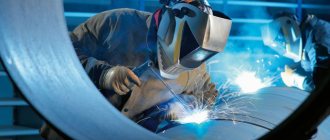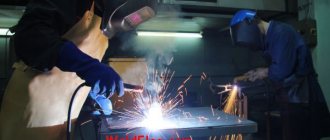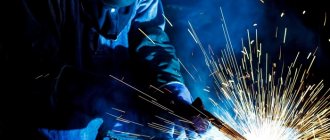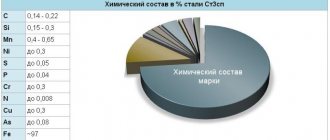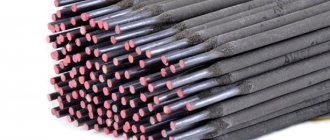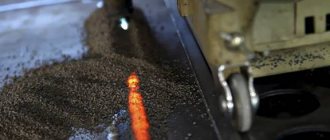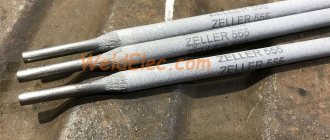At welding of low-carbon and medium-carbon structural steels it is necessary to take into account which steel weldability group a particular steel grade belongs to. Medium carbon structural steels contain more carbon than low carbon steels. And carbon greatly affects the weldability of steels.
Types of low alloy steel
Structural low-alloy steels are classified:
Types of low-carbon steels are presented in the table.
| Name | Marking examples |
| Chrome-silicon-nickel-copper | 10HSND, 15HSND |
| Chromium-silicon-manganese | 14ХГС |
| Manganese-nitrogen-vanadium | 14G2AF |
| Siliceous manganese | 14GS, 10G2S1, 09G2S |
| Manganese | 14G2, 14G |
Medium-carbon grades (35ХМ, 18Г2AF, 17ГС) contain more than 0.25% carbon and are used after heat treatment.
Heat-resistant metals have increased strength when working at high temperatures. They are used in the manufacture of metal elements of energy devices.
Due to the higher strength of low-alloy steels (compared to carbon structural steels), their use in the production of welded structures reduces weight and saves metal.
Due to these properties, the materials are used in railcar and shipbuilding, construction and other areas of industry.
Welding of low-carbon structural steels
The chemical composition of low-carbon steels contains up to 0.25% carbon; the weldability of such steels is good. They belong to the first group of weldability and can be welded without restrictions by all types of welding.
Electrodes for welding low-carbon steels
When manual arc welding of low-carbon steels, the choice of electrodes for welding them is based on many requirements:
- It is necessary to ensure the strength of the weld equal to the strength of the base metal;
- Defects in welds are not allowed;
- The weld must have a certain, required chemical composition;
- The welded joint must remain operational when exposed to vibration, shock loads, as well as at high or low temperatures.
Depending on the purpose of the welded structure, operating conditions and requirements for it, low-carbon steels are welded with E38, E42 and E42A electrodes. These types of electrodes correspond to the brands OMM-5, SM-5, UM-7, OMA-2, UONI-13/45, SM-11 and other brands.
Electrodes of type E38 are intended for metal structures that do not have high requirements. Electrodes of type E42 are used to weld critical structures made of low-carbon steels, which are subject to increased requirements. Electrodes of type E42A are intended for welding particularly critical metal structures.
Welding modes for low-carbon steels
Welding modes for low-carbon steels, depending on the type of electrode, are presented in the table:
Electrode brand
| Electrode diameter, mm | Welding current strength, A, at welding position | Character of welding current | Electrode calcination temperature, °C | |||
| lower | vertical | ceiling | ||||
| OMM-5 | 2 | 60-70 | 50-60 | 60-70 | Constant | 150 |
| 3 | 100-130 | 80-110 | 90-120 | |||
| 4 | 160-190 | 130-150 | 140-160 | |||
| 5 | 200-220 | 150-170 | Not applicable | |||
| TsM-7 | 4 | 160-190 | 130-150 | 140-160 | Constant, variable | 200 |
| 5 | 210-250 | 140-160 | Not applicable | |||
| 6 | 260-320 | Not applicable | Not applicable | |||
| OMA-2 | 2 | 25-45 | 20-45 | 20-45 | 100 | |
| 3 | 50-80 | 40-80 | 50-80 | |||
| UONI-13/45 | 2 | 45-65 | 30-40 | 30-45 | Constant | 350-370 |
| 3 | 80-100 | 60-80 | 70-90 | |||
| 4 | 130-160 | 100-130 | 120-140 | |||
| 5 | 170-200 | 140-160 | 150-170 | |||
| SM-11 | 4 | 160-220 | 140-180 | 140-180 | Constant, variable | 300-350 |
| 5 | 200-250 | 160-200 | Not applicable | |||
Before welding, it is necessary to calcinate the electrodes. The recommended calcination temperature for electrodes depends on their brand and should be indicated in the electrode data sheet.
Process Features
Low-alloy steel is a material belonging to the group of satisfactorily weldable metals that are joined by almost all types of welding.
- equal seam strength;
- obtaining the required form;
- no defects.
Welding low-alloy steel is more difficult than low-carbon structural steel. It is more sensitive to thermal influences. It should be taken into account that a content of more than 0.25% carbon in the material can lead to the formation of hardening structures and cracks in the weld, and carbon burnout can lead to the formation of pores.
To avoid the formation of hardening martensitic structures, the part is heated, multilayer welding is used, observing a minimum time interval between the application of metal layers to the seam. The material of the coated electrodes is selected with a low content of phosphorus, carbon and sulfur. This helps to increase the resistance of the seam against crystallization cracks.
Connection of chromium-silicon-manganese steels
This type of low alloy steel is also called chromansil. The composition includes carbon 0.17-0.4%, manganese 0.8-1.1%, silicon and chromium - 0.9-1.2%. The material is inexpensive, has good elasticity and strength, and can withstand vibration. Disadvantage: poor heat resistance.
During gas welding, chromium and silicon partially burn out, which leads to the formation of oxides, slags and lack of fusion in the joint. To avoid oxidation of alloying additives, the work is performed with a normal flame, the power of which is selected from the ratio of 75-100 dm 3 / h of acetylene per 1 mm of the thickness of the material being welded. Filler wire grades:
- low-carbon Sv-08 or Sv-08A - for non-critical structures;
- alloyed Sv-19KhMA, Sv-13KhMA, Sv-10KhGS, Sv-18KhGSA - for connecting critical objects.
The work process is carried out in one layer without interruption. The burner flame does not linger in one place to avoid overheating of the metal of the weld pool. To minimize warping, the seam is formed from the middle to the edges and back again. To avoid cracks, the welded element is cooled slowly.
Critical parts are hardened at a temperature of 500-650°C, with exposure and subsequent heating to 880°C. Cool in oil. Then it is released by heating to 400-600° and cooling in hot water.
Welding of structural low-alloy steels
- carbon up to 0.2%;
- alloying components – up to 2-3%.
The mechanical properties of these metals are higher than low-carbon ones. Silicon content in the range of 1-1.1% helps improve the strength and elasticity of the material. When it increases, the number of non-metallic inclusions in the weld increases, which complicates the welding process. Manganese from 1.6 to 1.8% enhances the material’s ability to harden, but technologically complicates the work process. An increased content of molybdenum, chromium, and vanadium negatively affects weldability.
Steels prone to hardening are welded:
- on soft mode without heat treatment (or in an oven);
- on hard mode with heat treatment in a spot machine.
The current strength when working with low-alloy materials is recommended to be 10-15% lower than when welding low-carbon steel. The pressure on the electrodes is 10-50% higher.
Welding is carried out using the same methods as for low-carbon steel - arc, gas and contact. Manual welding is performed with electrodes of the E-50A type, which will provide a seam with mechanical properties similar to the base metal.
Connection of steels 09G2S, 10G2S1, 10G2S1D
A distinctive quality of the low-alloy low-carbon steel grades 09G2S and 10G2S1 is the absence of a tendency to overheat and the formation of hardening structures. The work is carried out under any thermal conditions in compliance with process technology for low-carbon steels. Ensuring the uniform strength of the weld is achieved by electrodes E50A, E46A. The strength and hardness of the heat-affected zone is the same as that of the base metal.
Grade 10G2S1D is a low-alloy structural steel for welded products. When welding without restrictions, the process is performed without heating or heat treatment. The limited weldability of steel requires heating to 100-120° and heat treatment. Material that is difficult to weld requires additional actions: heating during welding to 200-300° and annealing after welding.
Welding of medium carbon structural steels
Welding of medium-carbon steels is complicated by the increased carbon content (up to 0.45%) in their composition, which can lead to the formation of cold cracks during welding, as well as the formation of low-ductility hardening structures in the heat-affected zone.
In order to reduce the risk of cracks in the weld metal, it is necessary to reduce its carbon content. This can be achieved by choosing electrodes with a reduced carbon content for welding, as well as by reducing the proportion of base metal in the weld.
Electrodes for welding medium-carbon steels and selection of welding modes
Welding of medium-carbon steels is carried out with electrodes of the following grades: UONI-13/45, UONI-13/55, UONI-13/65, OZS-2, ANO-7, ANO-8, ANO-11 and other grades.
Recommended welding modes, depending on the brand of electrode, are presented in the table below, as well as in the table above in the text:
| Electrode brand | Electrode diameter, mm | Welding current strength, A, at welding position | Character of welding current | Electrode calcination temperature, °C | ||
| lower | vertical | ceiling | ||||
| OZS-2 | 3 | 80-100 | 60-80 | 60-80 | Constant | 250-300 |
| 4 | 130-150 | 120-140 | 120-140 | |||
| 5 | 170-200 | 150-170 | Not applicable | |||
| UONI-13/55 | 3 | 80-100 | 60-80 | 70-90 | 350 | |
| 4 | 130-160 | 100—130 | 120-140 | |||
| 5 | 170-200 | 140-160 | 150-170 | |||
| 6 | 210-240 | 180-210 | Not applicable | |||
In order to reduce the risk of the occurrence of hardening structures, the product is preheated before welding, and collateral heating is performed during welding.
The recommended preheating temperature is 100-200°C. When welding thick metal, the heating temperature is slightly higher. Heating is performed at a distance of 50-70mm from the weld. After welding is completed, it is recommended to allow the welded joint to cool slowly.
Welding of thick metal is performed using a “cascade” or “slide” welding pattern. More details about these schemes are described on the page “Technology of manual arc welding Part 3. Manual arc welding technique." The use of these schemes helps to slow down the cooling of the welded joint. And this allows you to reduce the risk of hardening structures in the weld and the heat-affected zone.
Technology
Manual arc welding is the most common method of joining materials for welding structures, in which manually:
- arc is excited;
- the electrode is fed and moved.
The work is carried out with coated electrodes. The method involves burning a welding arc from an electrode onto the object being welded. The edges of the product are melted, the metal of the electrode rod and the electrode coating are melted. The base metal and electrode material crystallize to form a weld.
Marking features
Manufacturing standards and grades of low-alloy steels are determined by GOST 19282-73. It is used to work with rolled, wide-band, thick-sheet materials; the processing method is not important (it can be a shape, forging, stamping, etc.). Steel alloys are used in the construction of buildings, welding, assembling various structures, and in mechanical engineering.
According to GOST, the marking must indicate the following data:
- a group of numbers at the very beginning - indicates the percentage of carbon in steel;
- a letter for the alloying element, numbers indicating its percentage content (when less than 1%, the number is not indicated at all).
Example of marking on alloy 18ХГТ:
- carbon parts – 0.18%;
- manganese;
- chromium;
- titanium.
Since the numbers are not indicated, the remaining elements in the alloy are no more than 1%.
Common grades of low-alloy steels used in welding metal structures
Low-alloy steels, from which building structures are welded, contain no more than 0.25% carbon and no more than 3% alloying elements.
For the manufacture of metal structures for industrial and civil buildings, the most suitable steel grades are 15HSND, 14G2, 09G2S, 10G2S1, 10G2S1D, 16GS, 14G2AF, 16G2AF, etc.
Steel grades such as 18G2S, 25G2S, 35GS, 20KhG2Ts, etc. are well suited for the manufacture of welded gas pipes. The same grades are also used in the manufacture of reinforcement for reinforced concrete slabs.
Preparation for welding
Carbon and low-alloy steels are cut into blanks by gas, plasma or air-arc cutting, followed by cleaning of heating areas with cutting or abrasive tools until traces of fire cutting are removed.
Before assembling the joint, the edges to be welded to a width of 20 mm are cleaned to a metallic shine and degreased.
The joints are assembled using assembly jigs or using tacks. They are installed using filler wires of the same brand that will be used to weld the root seam.
The height of the tack should be equal to 0.6-0.7 of the thickness of the parts being welded, but not less than 3 mm, with a wall thickness of up to 10 mm, or 5-8 mm with a wall thickness of more than 10 mm.
Tack welding must be done with full penetration. Their surface must be thoroughly cleaned. Tacks with unacceptable defects should be removed mechanically.
The welding wire is calcined for 1.2-2 hours at a temperature of 150-250°C. Rust on the wire dramatically reduces the stability of the welding process. It is recommended to remove rust by etching the wire in a 5% solution of hydrochloric acid, followed by calcination for 1.5-2 hours at a temperature of 150-250°C.
What electrodes should be used to cook steel 09g2s
Due to its properties (small percentage of alloying components), low-alloy steel grade 09g2s does not overheat and is not hardened during welding. This makes it possible to weld steel and structures made from it with a wide range of welding electrodes.
Electrodes for welding low-alloy steels of grade 09 g2s with a temporary tensile strength of up to 60 kg/cm2 are designated “U”. (GOST 9467-75)
For manual welding use:
Electrodes UONII 13/45 (E 42a)
These electrodes are used to weld structures made of steel 09g2s, which have special requirements. And especially when welding in very low outside temperatures. The weld metal requires more stringent strength indicators.
The electrodes are characterized by minimal metal sputtering during welding.
Electrodes are selected depending on their linear size, which is associated with their diameters: from 300 mm to - 450 mm.
The diameter value and position of the switch determine the current strength (in A.)
According to reviews from welders, these electrodes have less impact on the quality of the deposited metal and do not deteriorate its properties. They also have excellent carbon removal ability.
The welded seams can withstand significant loads, which distinguishes these electrodes from others.
Electrodes UONII13/55 S (E 50a)
These electrodes are also used to weld structures made of steel 09g2s, which have special requirements. And especially when welding in very low outside temperatures (even in the Arctic). After welding with these electrodes, the weld metal meets the corresponding more stringent standards for ductility and impact strength.
Welding technology for carbon and low-alloy steels
The melting point of carbon steel is 1535°C
STEEL GRADE
WELDABILITY
TECHNOLOGICAL FEATURES OF WELDING
Carbon
St3; St4; St3kp; St4kp; Steel 10,15,20
Electrode wire: Sv-08G2S; Sv-08GS; Sv-07GS; Sv-12GS; Sv-10ХГ2С1 Flux-cored wires: PP-AN8; PP-AN10; PP-AN13; PP-AN21
Low alloy
10HSND;15HSND; 14HGS; 09G2; 09G2S;09G2SD
Protective medium: CO2; Ar+CO2 Electrode wire: Sv-08GS; Sv-08G2S; Sv-08KhGSM; Sv -08ХГ2СМ; Sv-08ХГСМА Flux-cored wires: PP-AN 54
Selecting welding mode parameters
Welding is performed using direct current of reverse polarity.
The diameter of the electrode wire is selected depending on the type of welded joint, the thickness of the metal being welded and the position of the seam in space.
Dependence of wire diameter on connection type and metal thickness
Wire diameter, mm
Metal thickness (mm) for connections
Seam position in space
corner
T-bar
overlap
